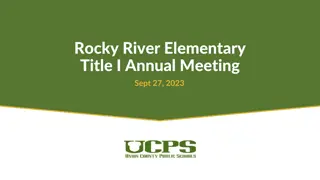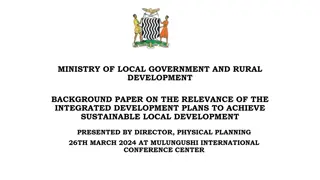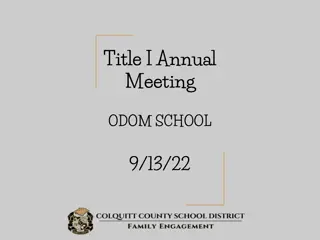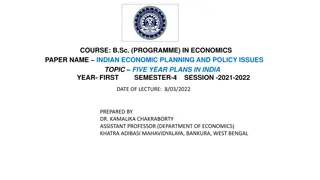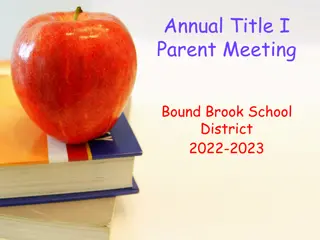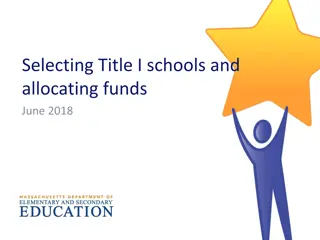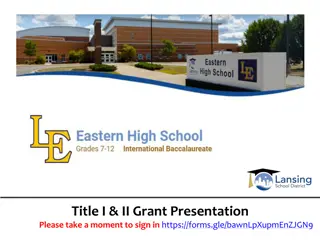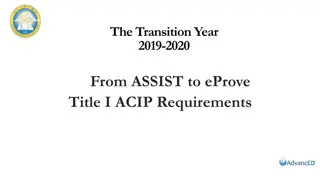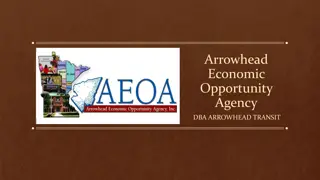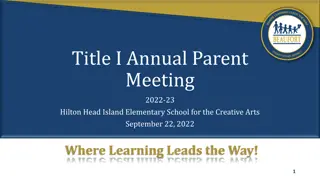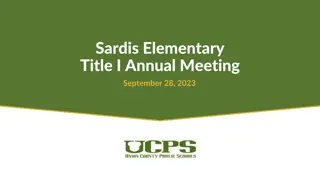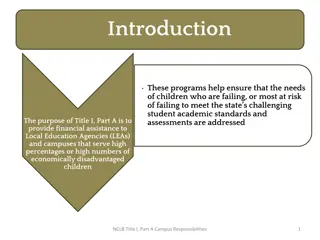Understanding Title I Part A School-Level Planning: Targeted Assistance Plans
Explore the differences between Targeted Assistance and Schoolwide Programs under Title I Part A, aimed at providing all children with equitable education opportunities and closing achievement gaps. Learn about program design, family engagement, and student progress monitoring. Discover the eligibility criteria, resources allocation, and student participation in both types of programs. Understand the common ground requirements and focus of Targeted Assistance Programs on identified students' needs.
Download Presentation

Please find below an Image/Link to download the presentation.
The content on the website is provided AS IS for your information and personal use only. It may not be sold, licensed, or shared on other websites without obtaining consent from the author. Download presentation by click this link. If you encounter any issues during the download, it is possible that the publisher has removed the file from their server.
E N D
Presentation Transcript
Title I, Part A: School-Level Planning Targeted Assistance Plans
Todays Agenda Targeted Assistance vs. Schoolwide Programs Digging Deeper into Targeted Assistance Plans o Assessing Needs o Program Design o Engaging Families o Student Progress Monitoring Oregon Department of Education 2
The purpose of Title I, Part A is to provide all children significant opportunity to receive a fair, equitable, and high-quality education, and to close educational achievement gaps. Purpose of Title I-A 3 Oregon Department of Education
Targeted Assistance vs. Schoolwide Programs Category Targeted Assistance Schoolwide School Eligibility Any school with a poverty level of 35% or the district s poverty average (whichever is lower). Any school with a poverty level of at least 40%.* *A school with less than 40% poverty may request to conduct a schoolwide program. Student Participation Resources are directed to students meeting the established targeting criteria. All students in the school have access to activities under a schoolwide plan. Professional Development Professional development with Title I funds focuses on staff that provide direct support to students identified for Title I services. Title I funds can be used to provide professional development for all staff. Planning & Evaluation Plan includes a general description of targeted assistance program activities to support students identified as eligible for services. The schoolwide plan must be developed for reforming the total instructional program in the school. Oregon Department of Education 4
Common Ground: TAS and SWP Both Targeted Assistance (TAS) and Schoolwide (SWP) plans must: be based on identified needs, include specific goals and strategies, and be developed and reviewed annually, with the input of families. Schoolwide Program Brief Targeted Assistance Program Brief Oregon Department of Education 5
Targeted Assistance Programs Targeted Assistance programs focus on the needs of specifically identified students Supports must be supplemental (in addition to core instruction), e.g.: Support in core academic subjects High dose tutoring Extended day/year/summer programs Mental health, SEL, and counseling supports Only identified students and staff can benefit Oregon Department of Education 6
Who is eligible? Students identified as failing, or most at risk of failing, to meet state standards; Students who participated in Head Start or attended a Title I preschool program in the prior two years; Students who qualify for migrant services; Students impacted by the justice system; and Students experiencing houselessness or housing insecurity. Oregon Department of Education 7
Targeted Assistance Plan Criteria Oregon Department of Education 8
Criteria & Continuous Improvement Criteria are organized under four categories Needs Assessment Program Design Family Engagement Student Progress Monitoring Criteria for Title I-A Targeted Assistance Plans Oregon Department of Education 9
Assess School Needs Who are our students? What data did we look at? Why are we choosing a Targeted Assistance Plan? Who was at the table? Community Engagement Toolkit Oregon Department of Education 10
Program Design Targeting Criteria What criteria do we use to determine student eligibility? Targeted Services o What interventions or services do eligible students receive? o How are services coordinated with the regular classroom schedule? Professional Learning How are staff being supported? Oregon Department of Education 11
Targeting Criteria Determination of students failing, or at risk of failing, must be made using multiple, educationally related, objective criteria Multiple (more than one) Educationally related (must include an academic component to the criteria) Objective (criteria cannot be based on teacher judgement or other subjective means) Oregon Department of Education 12
Family Engagement How are families involved in developing the plan and providing feedback? What steps do we take to remove barriers to participation by ALL families? How do we communicate about opportunities for family involvement in school activities? What are the strategies we use to help families support their student's learning? Oregon Department of Education 13
Student Progress Monitoring Plan Review What is our process for reviewing the progress of eligible students? How often is data reviewed and who is involved? Exit Criteria How do we know when students no longer need services? Oregon Department of Education 14
Moving from Targeted to Schoolwide 1. Conduct a comprehensive needs assessment 2. Determine priorities 3. Develop and submit a Schoolwide Plan to ODE Maintain documentation of: oTitle I-A Annual Meeting oFamily Engagement Plan oFamily-School Compact oBuilding Family Capacity oVerification of staff qualifications oParaprofessional qualifications Oregon Department of Education 15
Targeted Assistance Plan Criteria Resources Targeted Assistance Planning Template ESSA Quick Reference Brief: Targeted Assistance Programs ORIS Needs Assessment Tool for Schools Community Engagement Toolkit Tribal Consultation Toolkit Oregon Department of Education 16
Regional Contacts by ESD Amy Tidwell o Grant, Harney, High Desert, InterMountain, Jefferson, North Central and Region 18 Jen Engberg Clackamas, Columbia Gorge, Multnomah and Northwest Regional Lisa Plumb Lane, Linn Benton Lincoln and Willamette Sarah Martin Douglas, Lake, Malheur, South Coast and Southern Oregon Oregon Department of Education 17
Please reach out! Jen Engberg Jennifer.Engberg@ode.oregon.gov Sarah Martin Sarah.Martin@ode.oregon.gov Lisa Plumb Lisa.Plumb@ode.oregon.gov Amy Tidwell Amy.Tidwell@ode.oregon.gov Oregon Department of Education 18



